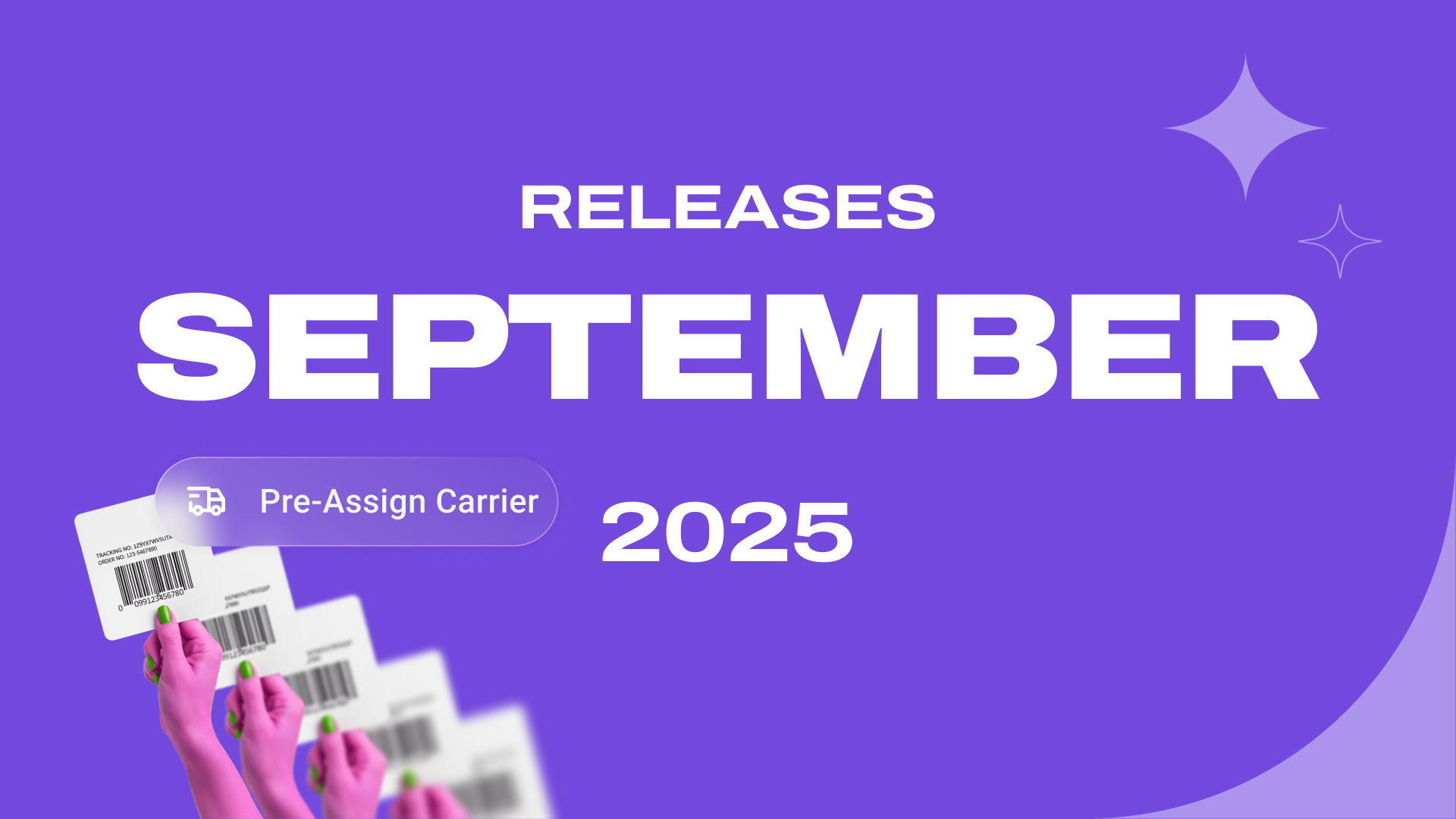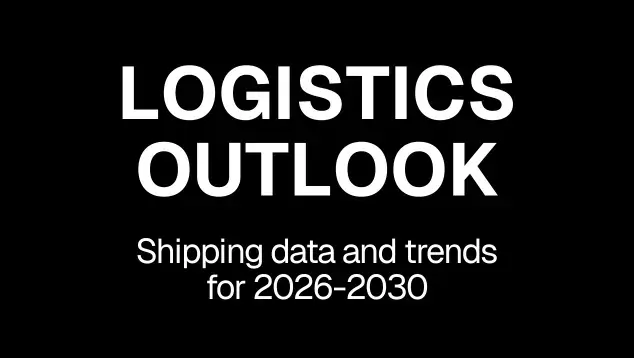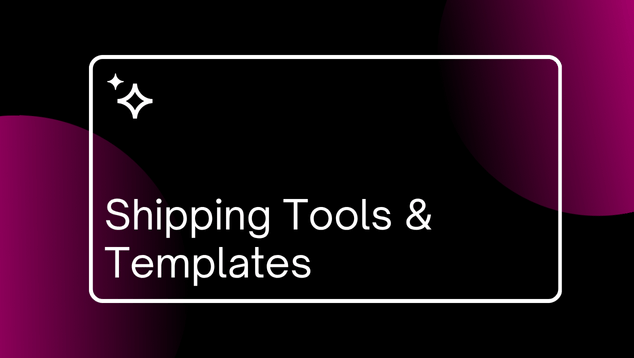Top 8 use cases of Artificial Intelligence in logistics
 By
Giulia Castagna
·
11 minute read
By
Giulia Castagna
·
11 minute read
In the face of labour shortages, regulatory pressure, and rising customer expectations, logistics managers are turning to AI not just to automate tasks, but to enhance decision-making, increase agility, and reduce waste across every node in the network.
Whether you're overseeing a complex multi-node distribution network or seeking to meet Scope 3 sustainability targets, these AI use cases will help you turn logistics complexity into a competitive advantage.
Use cases include dynamic route optimisation, AI-powered warehouse orchestration, and cold-chain risk reduction through IoT and machine learning. Generative AI is streamlining back-office tasks like document automation and multilingual support, while advanced analytics support carbon tracking and ESG compliance.
Platforms like ShippyPro integrate these capabilities across carrier selection, customs handling, and emissions reporting. AI is not just a tool for automation—it’s a strategic enabler for cost control, resilience, sustainability, and data-driven logistics orchestration at scale.
8 use cases of AI in logistics
Smart demand forecasting and inventory planning
Accurate demand forecasting and optimised inventory planning are pivotal to any logistics operation, particularly within complex, multi-node supply chains. Artificial Intelligence (AI) has become an indispensable tool in this space, enabling logistics professionals to move beyond historical trend analysis and into dynamic, predictive modelling based on real-time, multidimensional data inputs.
AI-powered forecasting models
Modern AI forecasting systems leverage supervised machine learning and neural networks to analyse variables well beyond conventional ERP data. These include external factors such as:
- Weather forecasts
- Promotional schedules
- Consumer sentiment via social media
- Macroeconomic indicators
- Public event calendars
The output? Near real-time forecasts that adjust automatically in response to new data inputs. For example, generative AI and transformers are now being used to simulate demand response scenarios, particularly useful in omnichannel retail or seasonal logistics where volatility is high.
Case study: Unilever’s AI-driven forecasting
Unilever's UK cold-chain logistics division reported a 10–12% improvement in forecast accuracy after deploying AI models trained on IoT sensor data, retail footfall analytics, and digital twin simulations of their supply chain operations (Business Insider, 2025). This gain translated into a measurable 5% reduction in perishable product waste and improved service levels across key accounts.
This example illustrates the move from reactive replenishment to prescriptive stocking, where inventory allocations are continuously recalibrated based on probabilistic demand distributions.
Benefits to logistics managers
For senior logistics leaders, the strategic value of AI in demand planning includes:
- Stockout mitigation: Real-time identification of low-supply SKUs using multi-variable anomaly detection.
- Inventory cost reduction: Leaner warehousing through just-in-time alignment across supplier tiers.
- Increased forecast granularity: Product-SKU-location-day level forecasting with 95%+ confidence intervals.
- Scenario planning: LLMs integrated into forecasting tools allow managers to test “what-if” disruptions like port delays, weather events, or fuel surcharges.
| Forecasting Method | Input Sources | Accuracy (avg.) | Update Frequency | Adaptability |
|---|---|---|---|---|
| Traditional Time Series | Historical sales data | 70–80% | Monthly | Low |
| ML Regression Models | Internal + external (weather, POS) | 85–90% | Weekly | Medium |
| AI Neural Networks | Real-time + IoT + sentiment data | 90–95%+ | Daily | High |
Enhanced supply chain visibility & control towers
Supply chain visibility has evolved from a dashboard feature to a strategic pillar of logistics resilience. In 2025, AI-driven visibility systems—often anchored in modern control tower architectures—enable end-to-end tracking, predictive exception handling, and scenario-based decision support at an unprecedented scale and precision.
From visibility to predictive insight
Traditional visibility platforms primarily track the “what” and “where” of shipments. In contrast, AI-enhanced systems predict “when”, “why”, and “what next”. These platforms aggregate structured (TMS, WMS, ERP) and unstructured data (emails, documents, weather feeds) across partners and nodes. Machine learning models then analyse this data to:
- Identify and flag bottlenecks before they occur
- Recommend optimal mitigation strategies
- Enable real-time collaboration across departments and geographies.
This shift transforms visibility into actionable intelligence, which is particularly valuable in high-velocity sectors such as ecommerce fulfilment or perishable goods transport.
Control Tower Architecture
An effective AI-powered control tower includes:
- Data lake layer: Aggregates live feeds from logistics networks, including IoT devices, courier APIs, and SCM platforms.
- AI/ML layer: Predictive models forecast disruptions and recommend remediations.
- LLM/Decision-support interface: Allows human planners to ask “why” questions (e.g. “Why are delays increasing on Route X?”) and receive explainable insights.
- Workflow automation: Automates alerts, escalation chains, and contingency workflows.
and dynamic optimisation
Strategic value for companies
For logistics managers, especially those managing international flows or high SKU counts, AI-driven visibility delivers:
- Faster exception resolution across multimodal networks
- Increased accuracy in ETA predictions
- Tighter alignment between procurement, production, and delivery
- Improved OTIF metrics (particularly valuable in B2B relationships).
In essence, AI control towers don’t just track—they think, simulate, and act. They enable a shift from fire-fighting to foresight, giving senior logistics leaders the clarity to make confident, strategic decisions in real time.
Smart warehouse automation & predictive quality
Warehousing, once viewed as a static cost centre, is becoming a technology-driven nexus of efficiency, flexibility, and resilience. AI-powered automation and predictive quality control are now central to warehouse transformation strategies, particularly for firms managing complex inventories or operating temperature-sensitive logistics.
Beyond robotics: AI as the orchestrator
While physical automation—robotic pickers, AGVs (automated guided vehicles), and sortation systems—has become widespread, the real differentiator in 2025 is the AI orchestration layer that governs these systems. AI models analyse order volumes, SKU velocity, staff availability, and storage density to dynamically reallocate labour, reroute workflows, and predict congestion zones within the warehouse.
For instance, machine vision systems trained via deep learning can detect subtle product anomalies or packaging defects during picking—often surpassing human quality control accuracy. These systems continuously learn, becoming more precise over time.
Predictive maintenance & downtime prevention
Another area where AI is adding value is predictive maintenance. By analysing sensor data (e.g. motor vibration, temperature, cycle time), machine learning models can forecast failures in conveyors, forklifts, and robotics. This allows for scheduled servicing, drastically reducing unplanned downtime.
Automation vs AI functionality
| Feature | Robotics only | Robotics + AI |
|---|---|---|
| Automated picking | ✅ | ✅ |
| Predictive maintenance | ❌ | ✅ |
| Real-time order flow optimisation | ❌ | ✅ |
| Defect detection (computer vision) | ❌ | ✅ |
| Dynamic slotting & replenishment | ❌ | ✅ |
Autonomous fleet & Last-Mile innovation
Autonomous technologies are reshaping how goods move from hubs to consumers—especially in the notoriously inefficient and cost-intensive last-mile segment. In the UK, regulatory pilots and AI-driven optimisation are accelerating adoption of autonomous vehicles (AVs), delivery robots, and drone-based transport. These innovations are not only addressing labour shortages but also improving delivery precision, sustainability, and cost control.
The state of autonomous vehicles in UK logistics
The UK market alone could be worth as much as £42 billion by 2035, creating as many as 38,000 jobs in the sector. (HM Government, 2025). Trials by UK logistics players such as DPD and Ocado have demonstrated that autonomous electric vans can reduce last-mile delivery costs by up to 30% in urban zones, particularly when combined with route optimisation AI.
Companies like Wayve, a British AV start-up backed by Microsoft and Virgin, are developing “embodied intelligence” for self-driving vans (read the PR) capable of learning from edge cases across UK road conditions—roundabouts, bus lanes, and unpredictable pedestrian behaviours. These are critical to unlocking scale in dense, regulation-heavy cities like London and Manchester.
Last-Mile drones: limited but emerging
Drone delivery remains in the early stages in the UK due to airspace regulation and urban density challenges. However, Royal Mail’s “Sky High” drone programme has seen promising success in remote locations like the Isles of Scilly, delivering medical supplies and parcels.
AI in fleet management & routing
Even before full autonomy, AI plays a critical role in semi-autonomous logistics operations:
- Dynamic route optimisation using real-time traffic, weather, and parcel clustering.
- Fleet orchestration platforms that balance energy consumption, load, and regulatory constraints (e.g., congestion charges, low-emission zones).
- Predictive energy management for electric delivery vehicles (EDVs) to optimise charging cycles and depot scheduling.
Strategic considerations for logistics managers
- Safety & compliance: Autonomous systems must meet UK’s Vehicle Certification Agency (VCA) standards. AI plays a role in compliance tracking, camera validation, and black-box recording.
- Labour upskilling: Autonomous systems don’t eliminate human roles—they shift them toward remote monitoring, fleet analytics, and incident response.
- Sustainability gains: AVs and drones reduce emissions by enabling lightweight electric transport, precision routing, and less idling.
Route optimisation & dynamic pricing
Route optimisation and dynamic pricing represent two of the most impactful applications of AI in modern logistics—directly affecting profitability, service levels, and sustainability. For UK logistics managers operating in densely regulated environments with fluctuating fuel costs, road congestion, and environmental targets, AI provides real-time responsiveness that manual planning simply can’t match.
Route optimisation:from static to self-adjusting networks
AI-powered route optimisation systems go far beyond basic shortest-path algorithms. They consider dynamic, real-world variables including:
- Real-time traffic data (e.g. congestion, road closures)
- Weather disruptions
- Fleet composition (e.g. vehicle load, fuel type)
- Time windows and delivery SLAs
- Emission zone restrictions
Machine learning models adjust route planning continuously throughout the day, using real-time feedback loops.
Dynamic pricing: real-time margin control
AI also empowers dynamic pricing of logistics services, especially relevant in the B2B freight and parcel sectors. Similar to airline ticket pricing, AI models can adjust delivery pricing based on:
- Current capacity and network load
- Fuel price fluctuations
- Weather and traffic disruptions
- Predicted demand surges (e.g. pre-Christmas spikes)
Strategic benefits for logistics managers
- Resilience under volatility: Rerouting in real time during strikes, storms, or port disruptions.
- Cost transparency: AI-generated estimates of per-route cost by energy type, driver availability, and zone compliance.
- Sustainability metrics: Real-time CO₂ tracking per route for ESG reporting.
Cold-Chain AI & Risk Reduction
Cold-chain logistics demands an extraordinary level of precision, traceability, and responsiveness. In sectors such as pharmaceuticals, perishable foods, and speciality chemicals, even minor deviations in temperature or timing can result in massive financial loss or regulatory non-compliance. AI is increasingly being deployed not just to monitor—but to predict and proactively mitigate—risks throughout the cold-chain network.
AI for real-time monitoring and predictive alerts
Modern cold-chain systems integrate AI with IoT-enabled temperature sensors, GPS trackers, and cloud-based visibility platforms. These models ingest continuous streams of data and use machine learning to:
- Identify patterns leading to spoilage risks
- Forecast equipment failures (e.g. reefer units)
- Flag out-of-tolerance excursions before thresholds are breached
For instance, AI models can detect abnormal thermal profiles that precede refrigeration failure—triggering alerts or automated escalation workflows well before spoilage occurs.
For logistics managers operating under MHRA or GDP (Good Distribution Practice) guidelines, AI also simplifies compliance reporting through automated audit trails, timestamped event logs, and real-time deviation resolution. Furthermore, AI-enhanced visibility tools offer a competitive edge in tenders for pharmaceutical and high-value food contracts—where traceability and reliability are key differentiators.
Unilever’s Cold-Chain AI Initiative
Unilever’s UK supply chain incorporates AI in cold-chain transport for ice cream and frozen food distribution. Their system leverages digital twins to simulate warehouse-to-store logistics, incorporating temperature, vehicle telemetry, and external factors like traffic and weather. The result: a 6% increase in delivery punctuality and double-digit percentage improvements in energy efficiency, according to their 2025 sustainability report.
Read more on Unilever's website →
Risk scoring and route re-ranking
Beyond temperature, AI also models external risk factors such as:
- Route-specific traffic congestion and delays
- Port disruption likelihood (e.g. from strikes or customs delays)
- Weather anomalies that increase fuel consumption or spoilage risk
Back-office automation & Generative AI
While AI is often associated with front-line logistics operations—vehicles, warehousing, routing—the back office remains one of the most fertile grounds for AI-driven transformation. Legacy administrative processes such as document handling, billing, claims processing, and customer support are still rife with inefficiencies, errors, and labour-intensive workflows. AI, particularly in its generative form, is now being deployed to digitise, interpret, and streamline these operations at scale.
RPA meets AI: automating administrative logistics
Traditional Robotic Process Automation (RPA) has long been used to mimic human interaction with legacy systems. However, RPA struggles with unstructured data. This is where AI-enhanced automation excels. By combining optical character recognition (OCR), natural language processing (NLP), and machine learning, AI tools can:
- Parse and validate customs documents and shipping manifests
- Auto-fill invoicing fields based on scanned waybills
- Reconcile freight bills against rate cards
- Extract insights from emails and PDF attachments
Generative AI: language models for logistics Admin
Generative AI, particularly large language models (LLMs), introduces a new layer of intelligence to back-office workflows. LLMs can:
- Draft customs declarations from structured and unstructured inputs
- Respond to customer service queries in multiple languages, adapted to carrier-specific terminology
- Generate anomaly reports for audit teams, citing specific time/location discrepancies
| Task | Traditional Approach | AI-Enhanced Outcome |
|---|---|---|
| Document scanning | OCR only (template-dependent) | NLP + ML (learns irregular formats) |
| Freight invoice reconciliation | Manual spreadsheet matching | Instant rate validation |
| Customer support (email/phone) | Tiered human escalation | LLM-generated first-response drafts |
| Discrepancy reporting | Manual incident tickets | Automated exception narratives |
| KPI tracking & reporting | Static dashboards | Conversational BI tools |
Strategic benefits for logistics leaders
- Compliance assurance: Automatically formatted documentation reduces penalties and improves regulatory audit outcomes (e.g. for HMRC or EU VAT filings).
- Staff reallocation: Admin teams can focus on exception handling rather than repetitive input, improving job satisfaction and reducing turnover.
- Scalability: AI solutions scale with volume—unlike human-dependent workflows, which bottleneck during Q4 peaks or regulatory change events.
Advanced analytics & sustainability
In 2025, logistics operations are being judged not just by speed or cost-efficiency—but by their environmental footprint, transparency, and responsiveness to real-time market dynamics. Advanced analytics, fuelled by AI, has become the key enabler for both high-performance logistics and meaningful sustainability gains.
From KPIs to decision intelligence
Traditional logistics metrics—like OTIF (on-time in-full), dwell time, or fuel consumption—are still foundational. But AI has elevated analytics into predictive and prescriptive realms, offering insights like:
- “Which suppliers are most likely to miss SLAs next quarter?”
- “How can we reduce emissions on route X without increasing cost?”
- “What’s the long-term cost of shipping via carrier A vs B during Q4 spikes?”
These models ingest data from across TMS, WMS, ERP, and telematics platforms, applying machine learning to surface patterns that human analysts would miss. For example, pattern recognition in temperature profiles, traffic delays, and package density can recommend adjustments to both carrier selection and load consolidation strategies.
UK ESG compliance & reporting
With the UK's Streamlined Energy and Carbon Reporting (SECR) regime and upcoming mandates under the EU CSRD, logistics companies operating in the UK are under pressure to deliver granular, auditable data on carbon emissions. AI-enabled carbon tracking platforms now:
- Attribute CO₂ emissions to specific routes, shipments, or modes
- Offer dynamic scenario planning (e.g. “What if we switched from road to intermodal for Lane Y?”)
- Automate reporting to align with GHG Protocol standards
Strategic value for UK logistics leaders
- Carbon cost forecasting: Model the long-term implications of carbon taxes, fuel volatility, and green carrier surcharges.
- Data-driven procurement: Prioritise carriers not just by price, but by predictive reliability and emissions score.
- Stakeholder confidence: Provide customers and investors with transparent, traceable ESG data—critical for tenders and partnerships.
In short, advanced analytics enables logistics managers to see around corners—balancing operational excellence with climate goals and compliance demands. As ESG moves from reporting obligation to competitive advantage, AI-driven sustainability intelligence becomes central to long-term success in the UK logistics ecosystem
ShippyPro: a scalable AI platform for growing logistics needs
With over 180+ courier integrations—including Royal Mail, Evri, DPD, and DHL—ShippyPro offers a centralised AI-ready interface for logistics professionals to:
- Automate repetitive tasks
- Analyse and act on real-time logistics data
- Enhance customer experience via branded tracking and returns portals
As AI becomes essential—not optional—in logistics strategy, ShippyPro is helping UK logistics managers turn intelligence into impact.
Experience the power of AI for shipping data analysis
Conclusion
As this deep dive illustrates, artificial intelligence is not just a tool for automation—it’s a strategic enabler of resilience, responsiveness, and competitive advantage. Whether through:
- Predictive demand planning that reduces stockouts,
- Real-time visibility systems that avert delivery failures,
- Autonomous technologies that streamline last-mile execution,
- Or advanced analytics that power carbon-conscious decisions,
AI empowers logistics managers to shift from reactive operations to proactive orchestration.
And critically, AI in logistics is accessible today. Platforms like ShippyPro are demystifying adoption by embedding intelligence directly into everyday workflows: courier selection, label generation, routing, customs compliance, and emissions tracking. No bespoke IT projects. No multi-year deployments. Just actionable insights and real-time optimisation, ready to scale with your business.
The question is no longer “should we use AI in logistics?”
It’s “how fast can we embed AI across our logistics network—and how far ahead will it put us?”
More on AI and Logistics
Top AI uses in logistics: FAQs
What are the top AI use cases in logistics?
AI is used for demand forecasting, route optimisation, warehouse automation, predictive maintenance, document processing, and sustainability analytics. These tools help logistics managers reduce costs, improve delivery accuracy, and anticipate disruptions in real time.
How does AI improve demand forecasting?
AI enhances forecasts by analysing real-time data—sales, weather, social sentiment, and economic signals—alongside historical trends. This enables more precise inventory planning and reduces stockouts, especially in fast-moving sectors.
Can generative AI be used in logistics?
Yes. Generative AI powers smart document automation, multilingual customer support, and natural-language analytics. It enables teams to extract insights, draft customs forms, and generate delivery reports using simple queries.
What ROI can logistics companies expect from AI?
AI typically delivers 10–30% savings across inventory, transport, and admin costs. ETA accuracy improves up to 94%, while carbon tracking and routing optimisations offer long-term ESG and cost benefits.
How does AI help manage cold-chain logistics?
AI monitors temperature data in real time and predicts equipment failures before they occur. It also optimises routing to minimise spoilage risks, reducing product loss by up to 28%.
Is the UK ready for autonomous logistics?
Yes. The UK has invested heavily in AV infrastructure and drone trials. Autonomous delivery pilots are active in urban and rural areas, with full rollout expected in the next 5–10 years.
What are the main barriers to AI adoption in logistics?
Key challenges include legacy systems, data silos, integration complexity, and regulatory compliance. Upskilling staff and ensuring cross-platform data flow are essential to AI implementation success.

Curious by nature, analytical by mindset, Giulia Castagna is the voice behind ShippyPro’s content. As Content Marketing Manager, she simplifies complex logistics topics for those who ship around the world every day. She writes about AI, automation, and shipping trends to inspire data-driven decisions.













